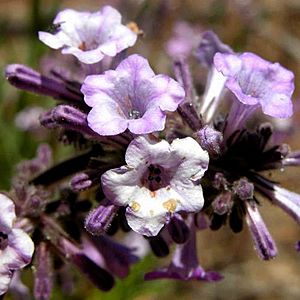Poodle-dog bush facts for kids
Quick facts for kids Poodle-dog bush |
|
|---|---|
 |
|
| Scientific classification | |
| Genus: |
Eriodictyon
|
| Species: |
parryi
|
| Synonyms | |
|
|
The Eriodictyon parryi, also known as poodle-dog bush, is a tall plant found in the mountains of California. It has pretty purple flowers. But be careful! This plant can cause a bad skin rash if you touch it. It grows best in places that have recently had a wildfire.
Contents
Where it Lives
This plant is found only in southern California and Baja California in Mexico. It's very common in the Transverse Ranges. You can also find it in the Coast Ranges and the Sierra Nevada.
Poodle-dog bush grows on rocky slopes and ridges. It likes areas that are between 1,000 and 2,300 meters high. It grows well in pine forests that have recently burned or had landslides. It helps stop the soil from washing away after a fire. This plant can cover burned hillsides with its beautiful purple flowers.
It often stays the main plant in these areas for about ten years. After that, other plants and young trees start to grow and take its place. But its seeds can stay in the soil for a long time. When the next fire or disturbance happens, the plant quickly grows back!
What it Looks Like
The poodle-dog bush is a medium-sized, woody plant that lives for many years. It has several main stems that grow up to 2 meters tall. Its leaves are long and narrow, sometimes with jagged edges. They can be from 4 to 30 centimeters long.
The plant flowers from June to August. It has groups of pretty bell-shaped flowers that are blue, lavender, or purple. Even when it's not flowering, the plant has a strong, sweet, minty, or sometimes unpleasant smell.
How to Spot It
The flower groups and hairy stems of the poodle-dog bush look a bit like other plants in the Phacelia group. But you can tell it apart because the poodle-dog bush grows much taller.
It can be harder to tell apart from other plants in its own group, Eriodictyon, like yerba santa. They smell similar. However, yerba santa plants do not cause skin rashes. They also don't grow as much in areas disturbed by fire.
Here are some ways to tell the poodle-dog bush from yerba santa:
- Poodle-dog bush flowers are about the size of your thumb. Yerba santa flowers are smaller, about the size of your pinkie finger.
- Poodle-dog bush has several stems that grow straight up from the ground. Each stem is covered in thick leaves, making it look like a cone.
- Poodle-dog bush grows quickly after a disturbance. If you see it mixed with other plants, it might look fresher and younger.
- Poodle-dog bush grows from seeds in burned areas. Yerba santa might grow back from its roots.
Plant Family
When the poodle-dog bush was first described by Asa Gray, it was put into the Nama group. Later, it was moved to its own group called Turricula. However, new scientific studies show that it might belong in the Eriodictyon group after all. Scientists are still studying this!
Skin Rash Warning
Like many plants in the forget-me-not family, the poodle-dog bush can cause a very bad skin rash if you touch it. It's similar to Poison oak. The rash can cause blisters that last for several weeks. Sometimes, the reaction doesn't start until a few days after you touch the plant.
Tiny hairs from the plant can stick to your skin and clothes. The rash is caused by special chemicals released by these hairs. Once your body has reacted to the plant once, it might remember it. This means that if you touch it again, even a small amount, old rash areas might flare up again.
To avoid the rash, learn to identify the plant and stay away from it. Wear gloves, long sleeves, and long pants if you are in an area where it grows. If your clothes get contaminated, do not wash them with other clothes.
Some Native American groups used this plant for medicine. For example, the Kawaiisu people used its leaves to help with swelling or rheumatism. However, there is no scientific proof that it works as a medicine.
See also
 In Spanish: Turricula parryi para niños
In Spanish: Turricula parryi para niños
Images for kids




